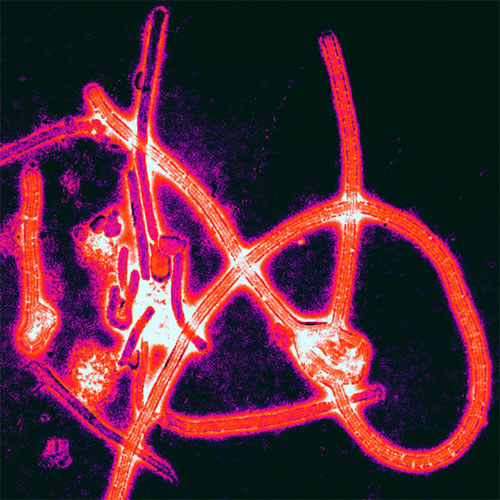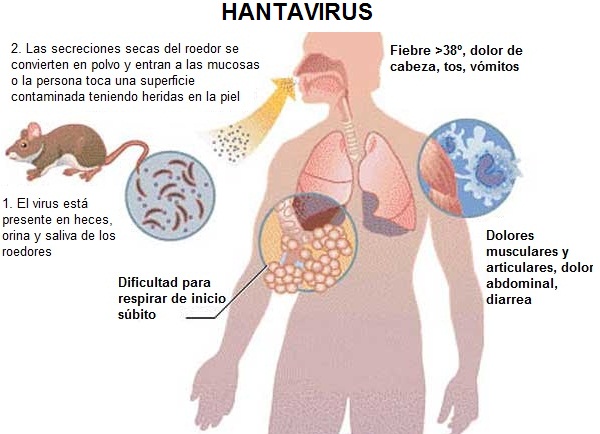Check out the most dangerous viruses on the planet
Ebola virus may be spreading terror, but not the most dangerous virus in the world. So is the HIV virus, because the most feared "killer" for humans is a relative virus with Ebola.
1. Marburg virus
Ebola's relatives virus is now considered the most feared virus for humans. Its name is named after a small, peaceful town by the Lahn River in the state of Hessen, Germany, which is linked to nothing that the virus causes. Marburg virus is actually a virus that causes dengue fever .
Marburg virus is transmitted through contact, from people who have come into contact with monkeys eating bad fruits from bats carrying germs. People with the disease will be attacked by viruses on key organs and major organs such as liver, kidneys, lungs, intestines, reproductive organs, salivary glands.
After invading organs, the virus will cause severe dengue fever: seizures and bleeding of mucous membranes, skin and internal organs, with a death rate of 50-100% after only 8 -10 days .

2. Ebola virus
There are 5 strains of Ebola in the world with each strain being named according to countries and territories in Africa: Zaire, Sudan, Tai Tai, Bundibugyo and Reston. In it, Ebola Zaire virus is the most dangerous type, with the ability to kill up to 90% . It is also a raging strain across Guinea, Sierra Leone, Liberia and Nigeria. Scientists say the flying fox may have brought the Ebola Zaire virus to cities in West Africa.
3. Hanta virus

Hanta virus is the common name for many virus strains. It is named after a river, where soldiers are thought to be the first to be infected with Hanta virus during the Korean War in 1950. Symptoms include lung problems, fever and kidney failure.
4. Chicken flu virus
Different strains of bird flu often cause panic, probably because of the high mortality rate of human infections up to 70%. However, in fact, the risk of infection with the H5N1 strain, one of the most well-known and relatively low-priced strains of bird flu. You can only get it from direct contact with birds and wild birds. That's why, most cases of bird flu occur in Asia, where ordinary people live close to chickens and ducks.
5. Lassa virus
A nurse in Nigeria was the first to be infected with Lassa virus. This virus spreads by mice. Once infected, the virus will appear in their urine, then enter the body through the way people eat or breathe.
Common symptoms of Lassa virus infection are nausea, tightness, tightness in the chest, then vomiting and bleeding.
In addition, the patient will have internal bleeding, causing multiple part bleeding, even blindness. The victim's heart will also beat much faster than usual, making the heart stop beating when exhausted.
The cases can be local, meaning the virus attacks a certain area, such as West Africa, and can be re-exported at any time. Scientists estimate that 15% of West African rodents carry Lassa virus.
According to statistics, there are about 300,000 people infected in Africa every year, of which about 5,000 deaths per year.
Although the mortality rate is quite low, patients usually die in less than 2 weeks if left untreated. In addition, there are currently no vaccines that can fight this disease.

6. Junin virus
This is the type of virus associated with Argentine dengue. People infected with the virus will develop tissue inflammation, infection and skin bleeding. The problem is that these symptoms seem so common that the disease caused by Junin virus is easily confused with other diseases and is rarely detected in the first place.
7. Crimea-Congo fever virus
Crimea-Congo fever virus spreads because the intermediate animal carries the disease as ticks. This virus is similar to the two Ebola and Marburg viruses on the development of the disease. In the first few days of infection, the patient will have petechiae on the face, mouth and throat.
8. Machupo virus
This virus is associated with Bolivia dengue fever . When entering the human body, the virus causes a high fever accompanied by severe bleeding. The course of the disease is similar to that of the Junin virus. Viruses can spread from person to person and mice are often considered to be vectors of transmission.
9. Kyasanur forest virus (KFD)
Scientists discovered the KFD virus in the coastal forests of southwestern India in 1955. The virus is thought to be spread by ticks, but researchers say it is difficult to identify any intermediates. transmission Bats, birds and wild boars can all be vectors. People with KFD will have high fever, severe headache, muscle aches and may have bleeding.
10. Dengue virus
Dengue fever is a permanent danger. If you are planning a vacation in the tropics, you need to know the information about dengue. The disease is transmitted by mosquitoes and attacks about 50 to 100 million people every year at popular tourist destinations like India and Thailand. The problem is even more serious for 2 million people living in the area threatened by dengue fever.
11. Rift Valley fever virus
This is also one of the dangerous viruses in Africa and Arab countries.

The virus is spread in many different ways, but it comes from a single source: from animals carrying pathogens.
The virus spreads from the air, spreads through the respiratory tract, or people who get sick from eating meat, drinking milk from carriers. Even mosquitoes also contribute to this outbreak.
This virus causes a dangerous Rift Valley fever, with mild to severe symptoms. Mild symptoms may include: fever, muscle aches, headache, and usually last for a week.
For severe cases, the patient may lose vision after 3 weeks, or a brain infection that causes severe headaches - causing confusion, even causing serious bleeding under the skin.
By the time of hemorrhage, the mortality rate of the disease is up to 50% and the patient will only keep up . the last 3 days.
Dangerously, this disease still has no cure, but can only supplement the patient's resistance. The only method to help prevent Rift Valley fever is full vaccination.
12. Virus Nipah
This is an " emerging" virus that can infect both animals and humans, and is spread by . bats.
Bacterial bats will eat fruits, leaving Nipah virus on it. After that, the virus will be transmitted directly to humans after eating fruit, or after humans eat meat and milk from the fruit-eating cattle.
Nipah virus was first discovered in 1998 after the outbreak of a disease in a village called Nipah (Malaysia). Some people have been infected by eating a pig containing a virus.

After infiltrating into the human body, the virus can cause a number of unexplained infections. The patient may have acute respiratory infections, and even severe cases of encephalitis lead to death.
The death rate of the disease caused by Nipah virus is up to 40-70%. There is no vaccine for both humans and animals. The main treatment for people is intensive care and support.
13. Crimean-Congo hemorrhagic virus (CCHF)
Crimean-Congo hemorrhagic fever is a disease caused by the most widespread RNA virus in Africa and the Balkans, the Middle East and Asia.

CCHF virus is transmitted from animals to humans - mainly from livestock species - through the bite of parasitic ticks, or by direct contact with infected animals.

CCHF spreads through the beetle Hyalomma marginatum - living parasites on cattle
People with the disease caused by CCHF will experience symptoms of the common cold for 1-7 days, but then there will be signs of mental disorder and petechia throat. The next symptoms will be nosebleeds, vomiting and black stools.
However, if not treated properly, the patient will usually "get" in 7 - 14 days.The mortality rate of the disease caused by CCHF virus is about 30%.
- The most dangerous computer viruses of the time
- The US removed the ban on fundraising for research on
- In the plethora of deadly epidemics, what is the most dangerous virus in history?
- Detection of new dangerous influenza viruses
- Top 10 most dangerous viruses in November
- Electronic check
- Video: Dangerous germs hidden in Arctic ice are melting
- Why are more and more new viruses threatening humans?
- Warning of dangerous viruses transmitted from monkeys to humans
- More and more viruses are dying around the world, and the reason is not pleasant at all
- Computer virus appearances can
- 10 most dangerous viruses of all time
 Why do potatoes have eyes?
Why do potatoes have eyes? 'Tragedy' the world's largest carnivorous life: Death becomes ... public toilet
'Tragedy' the world's largest carnivorous life: Death becomes ... public toilet Tomatoes were once considered 'poisonous' for 200 years
Tomatoes were once considered 'poisonous' for 200 years Detecting microscopic parasites on human face
Detecting microscopic parasites on human face